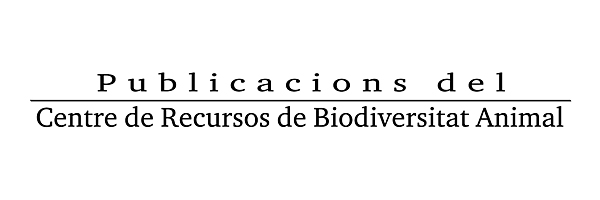Dreceres
Horari
-
De dilluns a dijous de 9 a 13h i dimarts de 15 a 17h.
Novetats
-
Tancat del 18 de desembre al 7 de gener
Notícia | Thu Dec 18 01:00:00 CET 2025 -
Resultats del Concurs de Fotografia de Natura fotoNAT-UB 2025
Concurs fotoNAT-UB | Wed Dec 17 01:00:00 CET 2025 - Exposicions | Tue Dec 16 01:00:00 CET 2025
-
Curs d'Il·lustració Científica: Aus, Rèptils, Amfibis i Peixos - Edició de març de 2026
Cursos | Tue Mar 03 01:00:00 CET 2026 - Cursos | Tue Mar 03 01:00:00 CET 2026
-
Curs de Fotografia de la Natura (II): Perfeccionament - Edició de maig de 2026
Cursos | Tue May 05 02:00:00 CEST 2026 - Publicacions | Mon Jul 14 02:00:00 CEST 2025
- Publicacions | Fri Jun 28 02:00:00 CEST 2024
-
Guardó IMPULS a la Formació Permanent per al CRBA
Notícia | Tue May 14 02:00:00 CEST 2024 - Publicacions | Fri Sep 15 02:00:00 CEST 2023
-
Contribució al catàleg dels àcars Oribàtids (Acari, Oribatida) de Catalunya. Primera aportació.
Publicacions | Fri Jul 21 02:00:00 CEST 2023 -
Exposició de la Col·lecció Mercè Durfort
Notícia | Fri Jun 23 02:00:00 CEST 2023 - Publicacions | Wed Jun 29 02:00:00 CEST 2022
-
Interacciones mutualistas entre animales y plantas. Addenda. Vídeos
Publicacions | Fri May 27 02:00:00 CEST 2022
-
Curs d'Il·lustració Científica: Aus, Rèptils, Amfibis i Peixos - Edició de març de 2026
Cursos | Tue Mar 03 01:00:00 CET 2026 - Cursos | Tue Mar 03 01:00:00 CET 2026
-
Curs de Fotografia de la Natura (II): Perfeccionament - Edició de maig de 2026
Cursos | Tue May 05 02:00:00 CEST 2026
- Publicacions | Mon Jul 14 02:00:00 CEST 2025
- Publicacions | Fri Jun 28 02:00:00 CEST 2024
- Publicacions | Fri Sep 15 02:00:00 CEST 2023
-
Contribució al catàleg dels àcars Oribàtids (Acari, Oribatida) de Catalunya. Primera aportació.
Publicacions | Fri Jul 21 02:00:00 CEST 2023 - Publicacions | Wed Jun 29 02:00:00 CEST 2022
-
Interacciones mutualistas entre animales y plantas. Addenda. Vídeos
Publicacions | Fri May 27 02:00:00 CEST 2022
- Exposicions | Tue Dec 16 01:00:00 CET 2025
-
Exposició de la Col·lecció Mercè Durfort
Notícia | Fri Jun 23 02:00:00 CEST 2023
-
Resultats del Concurs de Fotografia de Natura fotoNAT-UB 2025
Concurs fotoNAT-UB | Wed Dec 17 01:00:00 CET 2025
-
Tancat del 18 de desembre al 7 de gener
Notícia | Thu Dec 18 01:00:00 CET 2025 -
Guardó IMPULS a la Formació Permanent per al CRBA
Notícia | Tue May 14 02:00:00 CEST 2024 -
Exposició de la Col·lecció Mercè Durfort
Notícia | Fri Jun 23 02:00:00 CEST 2023






